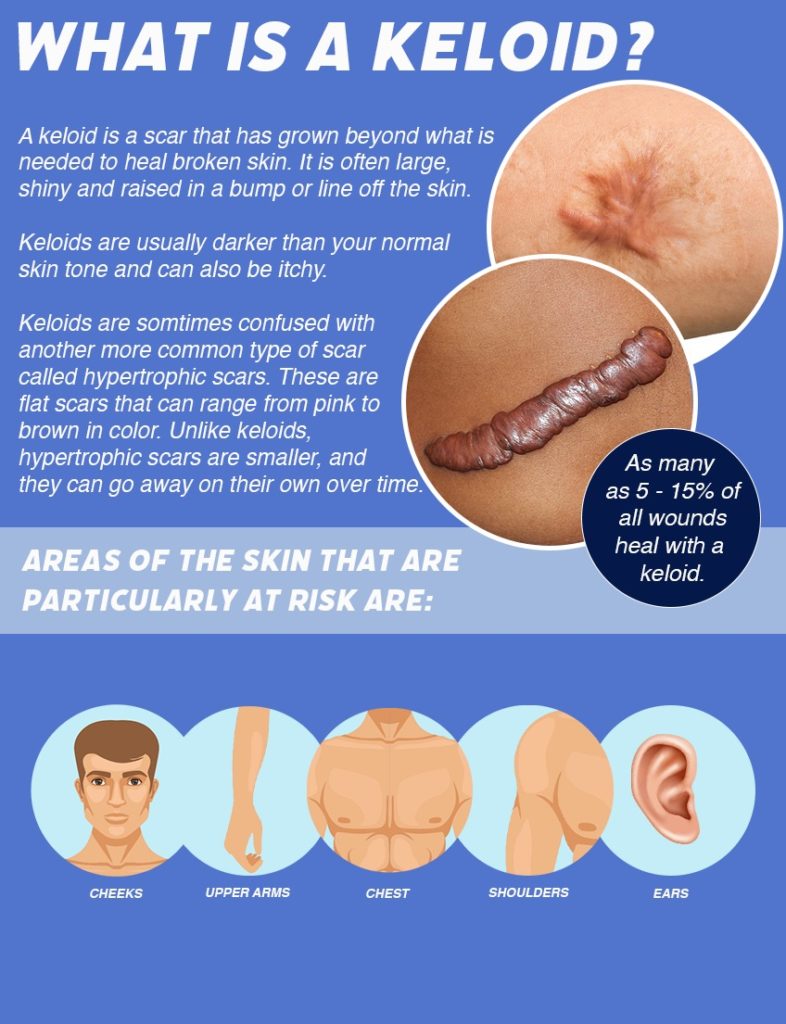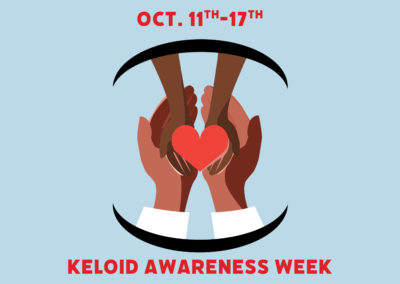A keloid, or keloid scar, is an overgrown scar, or an overly aggressive healing response to a wound. Sometimes a smooth, raised, shiny scar that is usually larger than the original injury and darker than the surrounding skin. Keloids can develop from head to toe; most often forming on the ears, neck, chest, back, and shoulders. While there are theories, the specific cause of keloids is still undetermined.

Those of African, Hispanic, or Asian descent; those with a family history of keloids; and people younger than thirty are more likely to develop keloids. Keloids are usually harmless and do not turn into cancer. Keloids can be very hard on a person’s self-esteem and sometimes inhibit proper body movement and sleep.
At LPS, we’ve solved everything from mild to extreme keloid cases. Check out these incredible before and afters!

If a keloid becomes larger, itchy, painful, tender, or reduces your joint flexibility, seek medical attention immediately. When a keloid needs to be removed, it requires a skilled surgeon. Removal can cause the keloid to return and grow further.
Dr. Michael Jones is a leading force in keloid surgical procedures. His methodology has over a 90% success rate of preventing the recurrence of this skin disorder using his multifaceted yet personalized program that may involve: The Sensus Healthcare Superficial Radiation Therapy (SRT-100 which allows for a low-energy radiation dose to be specifically directed to the keloid area only); the Candela VBeam Pulsed Dye Laser; appropriate dissolvable sutures that won’t cause additional trauma; Platelet Rich Plasma Surgical Excision; removal; and follow up continued skin care.
Dr. Jones has successfully treated over 6000 patients, all with different stories and backgrounds making LPS the premier destination for Keloid Removal. LPS has Keloid Removal in its offices in NYC, Cliffside, DC, Atlanta, Miami, Houston, and Los Angeles.
Dr. Jones created a skin care line featuring a trio of topical creams for scars and wounds:
ScarShield – reduces the appearance of scars and hyperpigmentation
Luminaire – works to calm the skin and reduce fine lines
Keloid Care – specifically treats the appearance of thick, raised scars like keloids and any discoloration of the surrounding area. While Keloid Care works for all skin types, Dr. Jones formulated it to provide maximum improvement in people of color who are more prone to keloids.

For some, a keloid arrives after ear piercing, a tattoo, surgery, cut, burn, acne, chickenpox. After an injury, a keloid may first appear three to twelve months later. Most keloids appear within one year of skin injury. Spontaneous keloids can spontaneously appear where there has been no injury to the skin.
Once keloids have started to form, they can enlarge for months. The size and shape of keloids vary, based on where they appear. When a keloid appears on the earlobe, it’s likely to be round or oval and firm. When the keloid appears on the chest, legs, or arms, it is likely to be a raised scar with a flat surface, and tender. Keloids rarely appear on eyelids, genitals, palms or soles.
The size of keloids ranges from being less than an inch in length to longer than the length of a football with the largest keloids forming on the shoulders and back. The appearance of keloids can begin with sightings of raised pink, red, or purple scars on the body. They may become darker in color over time. Upon palpating the scar, a definitive difference can be felt with the rest of the skin, where the keloid may feel soft and doughy or hard and rubbery. Keloids will cause pain, itching or tenderness while they are growing. Once the keloid stops growing, these symptoms may stop too.
![iStock-1216047905 [Converted]-01](https://lexingtonplasticsurgeons.com/wp-content/uploads/2021/08/iStock-1216047905-Converted-01-1.png)


